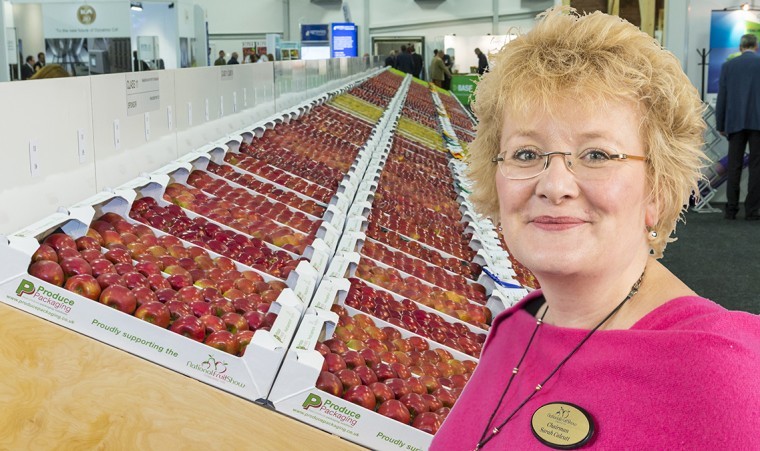The recent Agrovista technical day was well thought out, and given it is the large number of growers present, something that is becoming an important part of the winter CPD for the industry.
Chaired by Paul Bennet the day began with the good news that the team is expanding. Simon Warren has joined the team from S&A Davis and will be based in Kent, David Taylor has joined from Berry Gardens and will be based in the West Midlands. Speakers covered topics such as the weather prediction models, new plum potential, the application of RGPro Horti to Established Orchards (the incorporation of beneficial mycorrhizal fungi), BASF’s new Sercadis product, Michelle Fountain reporting on pear bud weevil hunting in the small hours and a canker research update.
Alex Radu was first on the programme talking about the company’s GCI – Growers choice interactive system. The system tracks a weather model and the programme, through the RIMpro cloud based site, provides accurate pest and disease prediction models. The weather in 2016 had posed some significant challenges for growers, there were issues with hail and flooding in some regions and of course harvest conditions all contributing towards P&D pressures through the season and into the storage term too. There are models for all the major P&D pressures on fruit growers; Neonectria, Erwinia, scab, codling moth, sawfly and mildew is being added for the 2017 season. One of the benefits of such a system to growers is the ability to be able to be accurately pre-emptive in protection product applications, Alex’s presentation also showed that the model can accurately predict if a sporulation will actually lead to infection too, thus preventing unnecessary applications.
Leon Jahae got attendees thinking about the challenges around revitalising the plum production of the UK. There is a massive challenge in that we have a limited number of really good varieties with a massive number of good fruits not being evaluated. There is a distinct lack of innovation in terms of new varieties of European plum (Stanley and President which are processing, with no wow factor) there is generally poor quality fruit available in the fresh market, which is primarily linked to shelf life requirements dictating an early harvest. There are Japanese plums in our market place, but again picked too early for shipping and reliant on their looks not their flavour.
There are challenges for plum growers outside of the commercial choice and depressed market place – a good plum criteria looks like this:
- Split tolerant/resistant
- Low monilinia susceptibility
- Stone must be firm, no broken stones
- Superb taste and shelf life – combined
To revitalise our market place we need a fresh start and an open mind, we need to leave the varieties we grow behind!
What is needed?
- A season from June to middle of October for UK plums
- Substitute imported fruit and substitute apricots, peaches and nectarines
- Best eating quality experience and shelf life + disease and virus resistance/tolerance
- Consistent yields, not early flowering and should they be covered?
- We need a retailer partner on board from the start!
Leon identified three groups that we should be looking at:
- Smaller size plums – 35-40mm and weight of at least 30g
- Colour – dark blue
- Very high brix
- Harvest from end of June till the end of October.
- Large sized plums, at least 50mm and weight of at least 45g
- Orange flesh and in direct competition with apricots, nectarines, peaches and Japanese plums
- Colour- varying from violet/red to dark blue
- Harvest from end of June till the end of October.
- Third niche group – an important product for a grower?
- Gages – Reine Claude types. There are many other than just green. Hybrids can be very attractive
- Hybrids – crossings between Japanese and European plums that suit northern European conditions
- Hybrids – European x prunus cerasifera
- Mirabelles – a very small plum (26/28mm) these grow well in the UK
- Culinary plums are different – long shape with a fold
Planting systems
We need to look ahead to the technology that will be available in 20 years when orchards will still be cropping well. IE robots for harvesting, so a narrow hedge with fruit grown on the ‘outside’ for ease of picking. Growers should also be considering a multi leader system – dividing the apical dominance (2.22 tall average), add netting for drosophila control into your costings too… rootstocks are crucial in preventing yield reduction by the Sharka virus, for now WaxWa, Wavit and Weiwa are the best options with Docera6 something to move to in the future (low volumes of propagated material at present).
Good news came from Simon Townsend in the form of the new BASF scab and mildew product Sercadis. Delivering a long lasting and robust control for quality top fruit, it is also tank mix compatible, has added benefits in leaf size and crop cosmetic finish. The LERAP is 15m, the phi is 15 days and you get three applications a year, no more than two consecutively. Trials have show that Bellis + Sercadis gives scab, mildew and storage disorder cover.
And finally: dates for your diary – the Fruiterers conference is on 16 March, please book soon as seats are limited for this important event www.fruiterers.org.uk/conference/ MFSS National Fruit show AGM 11 April, Hadlow College Animal Management Lecture theatre




